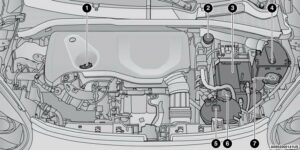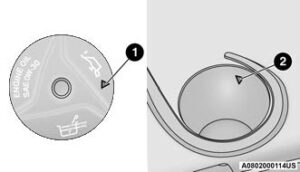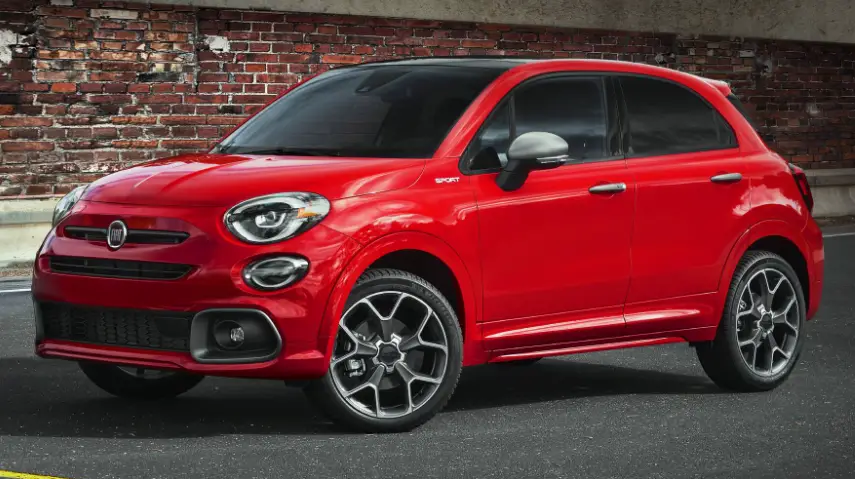2021 Fiat 500X Maintenance Schedule
The 2021 Fiat 500X Maintenance Schedule is a vital reference for maintaining your vehicle in top shape. Maintenance ensures the durability, functionality, and security of your Fiat 500X. This comprehensive schedule contains a comprehensive plan for routine maintenance duties, such as oil changes, tire rotations, and brake inspections. By adhering to this maintenance schedule, you can not only extend the life of your 2021 Fiat 500X, but also enjoy a trouble-free and seamless driving experience. This manual is the key to preserving your vehicle’s value and ensuring its optimal performance, so let’s delve into the specifics of this essential maintenance program for your Fiat 500X.
MAINTENANCE PLAN
| At Every Oil Change Interval As Indicated By Oil Change Indicator System: |
| Change oil and filter. |
| Inspect battery and clean and tighten terminals as required. |
| Inspect the CV/Universal joints. |
| Inspect brake pads, shoes, rotors, drums, and hoses. |
| Inspect engine cooling system protection and hoses. |
| Check and adjust hand brake. |
| Inspect exhaust system. |
| Inspect engine air cleaner filter if using in dusty or off-road conditions. |
NOTE:
Using white lithium grease, lubricate the door hinge roller pivot joints twice a year to prevent premature wear.
| Mileage or time passed (whichever comes first) | 10,000 | 20,000 | 30,000 | 40,000 | 50,000 | 60,000 | 70,000 | 80,000 | 90,000 | 100,000 | 110,000 | 120,000 | 130,000 | 140,000 | 150,000 |
| Or Years: | 1 | 2 | 3 | 4 | 5 | 6 | 7 | 8 | 9 | 10 | 11 | 12 | 13 | 14 | 15 |
| Or Kilometers: | 16,000 | 32,000 | 48,000 | 64,000 | 80,000 | 96,000 | 112,000 | 128,000 | 144,000 | 160,000 | 176,000 | 192,000 | 208,000 | 224,000 | 240,000 |
| Check tire condition/wear and adjust pressure, if necessary, check Tire Service Kit expiration date (if provided). | • | • | • | • | • | • | • | • | • | • | • | • | • | • | • |
| Check operation of lighting system (headlamps, direction indicators, hazard warning lights, luggage compartment, passenger compartment, glove compartment, instrument panel warning lights, etc.). |
• |
• |
• |
• |
• |
• |
• |
• |
• |
• |
• |
• |
• |
• |
• |
| Check and, if necessary, top up fluid levels (brakes/hydraulic clutch, windshield washer, engine coolant, etc.). | • | • | • | • | • | • | • | • | • | • | • | • | • | • | • |
| Check engine control system operation (via diagnostic tool). | • | • | • | • | • | • | • | • | • | • | • | • | • | • | • |
| Visually inspect condition of: exterior bodywork, underbody protection, pipes and hoses (exhaust – fuel system – brakes), rubber elements (boots, sleeves, bushings, etc.). |
• |
• |
• |
• |
• |
• |
• |
• |
|||||||
| Check windshield/rear window wiper blade position/wear. | • | • | • | • | • | • | • | • | |||||||
| Check operation of windshield washer system and adjust jets if necessary. | • | • | • | • | • | • | • | • | |||||||
| Check cleanliness of hood and tailgate locks and cleanliness and lubrication of linkages. | • | • | • | • | • | • | • | ||||||||
| Visually check the condition and wear of the front and rear brakes. | • | • | • | • | • | • | • | • | • | • | • | • | • | • | • |
| Mileage or time passed (whichever comes first) | 10,000 | 20,000 | 30,000 | 40,000 | 50,000 | 60,000 | 70,000 | 80,000 | 90,000 | 100,000 | 110,000 | 120,000 | 130,000 | 140,000 | 150,000 |
| Or Years: | 1 | 2 | 3 | 4 | 5 | 6 | 7 | 8 | 9 | 10 | 11 | 12 | 13 | 14 | 15 |
| Or Kilometers: | 16,000 | 32,000 | 48,000 | 64,000 | 80,000 | 96,000 | 112,000 | 128,000 | 144,000 | 160,000 | 176,000 | 192,000 | 208,000 | 224,000 | 240,000 |
| Check the front suspension, tie rods and replace if necessary. | • | • | • | • | • | • | • | ||||||||
| Inspect the CV/Universal joints. | • | • | • | • | • | • | • | • | • | • | • | • | • | • | • |
| Visual inspect the condition of the accessory drive belt. | • | ||||||||||||||
| Check the tension of the accessory drive belt. | • | • | |||||||||||||
| Inspect and replace, if required, front end accessory drive belt, tensioner, and, idler pulley. | • | • | |||||||||||||
| Inspect and replace PCV valve if necessary. | • | ||||||||||||||
| Change engine oil and replace oil filter. 1 | In accordance with Oil Change Indicator System OR Severe Duty Mileage, whichever occurs first. | ||||||||||||||
| Inspect the PTU fluid level. | • | • | • | ||||||||||||
| Inspect the rear differential fluid level. | • | • | • | ||||||||||||
| Replace spark plugs. 2 | • | • | • | ||||||||||||
| Replace engine air cleaner filter. 3 | • | • | • | • | • | • | • | ||||||||
| Replace brake fluid every two years. | • | • | • | • | • | • | • | ||||||||
| Mileage or time passed (whichever comes first) | 10,000 | 20,000 | 30,000 | 40,000 | 50,000 | 60,000 | 70,000 | 80,000 | 90,000 | 100,000 | 110,000 | 120,000 | 130,000 | 140,000 | 150,000 |
| Or Years: | 1 | 2 | 3 | 4 | 5 | 6 | 7 | 8 | 9 | 10 | 11 | 12 | 13 | 14 | 15 |
| Or Kilometers: | 16,000 | 32,000 | 48,000 | 64,000 | 80,000 | 96,000 | 112,000 | 128,000 | 144,000 | 160,000 | 176,000 | 192,000 | 208,000 | 224,000 | 240,000 |
| Replace cabin filter. | ○ | • | ○ | • | ○ | • | ○ | • | ○ | • | ○ | • | ○ | • | ○ |
| Flush and replace the engine coolant at 10 years or 150,000 miles (240,000 km) whichever comes first. | • | • |
- The oil and oil filter replacement must be carried out when indicated by a warning light or message on the instrument panel, or in any case should not exceed 1 year or 10,000 miles (16,000 km).
- The spark plug change is distance-based only, yearly intervals do not apply.
The following are essential to ensure correct operation and prevent serious damage to the engine:- Only use spark plugs of the same make and type which are specially certified for such engines.
- Strictly comply with the spark plug replacement interval given in the Maintenance Plan for spark plug replacement.
- Contact an authorized dealer if you have any questions.
- The engine air cleaner filter should be inspected at every oil change if used in dusty areas.
- Recommend replacement
- Mandatory service
WARNING
- You can be badly injured working on or around a motor vehicle. Do only service work for which you have the knowledge and the right equipment. If you have any doubt about your ability to perform a service job, take your vehicle to a competent mechanic.
- Failure to properly inspect and maintain your vehicle could result in a component malfunction and effect vehicle handling and performance. This could cause an accident.
ENGINE COMPARTMENT
L TURBO ENGINE
- Oil Fill Cap/Engine Oil Dipstick
- Engine Air Cleaner Filter (Located Under Engine Cover)
- Brake Fluid Reservoir Cap
- Battery
- Power Distribution Center (Fuses)
- Engine Coolant Reservoir
- Engine Coolant Pressure Cap
- Washer Fluid Reservoir Cap
CHECKING OIL LEVEL
To ensure proper engine lubrication, the engine oil must be maintained at the correct level. Check the oil level at regular intervals, such as every fuel stop. The best time to check the engine oil level is about five minutes after a fully warmed-up engine is shut off. Checking the oil while the vehicle is on level ground will improve the accuracy of the oil level readings.
NOTE:
The dipstick is integral with the cap.
Engine Oil Cap/Dipstick Installation
Install the oil cap/dipstick aligning arrow on the cap with an arrow on the engine cover and then screw the cap down.

- Oil Cap/Dipstick Arrow
- Engine Cover Arrow
There are four possible dipstick types:
- Crosshatched zone.
- Crosshatched zone marked SAFE.
- Crosshatched zone marked with MIN at the low end of the range and MAX at the high end of the range.
- Crosshatched zone marked with dimples at the MIN and the MAX ends of the range.
NOTE:
Always maintain the oil level within the crosshatch markings on the dipstick.
Adding 1 quart (1 liter) of oil when the reading is at the low end of the dipstick range will raise the oil level to the high end of the range marking.
CAUTION
Overfilling or underfilling the crankcase will cause aeration or loss of oil pressure. This could damage your engine.
ADDING WASHER FLUID
The windshield washer fluid reservoir is located in the engine compartment, and the fluid level should be checked at regular intervals. Fill the reservoir with windshield washer solvent (not engine coolant/ antifreeze).
WARNING
Commercially available windshield washer solvents are flammable. They could ignite and burn you. Care must be exercised when filling or working around the washer solution.
MAINTENANCE-FREE BATTERY
Your vehicle is equipped with a maintenance-free battery. You will never have to add water, and periodic maintenance is not required.
WARNING
- Battery fluid is a corrosive acid solution and can burn or even blind you. Do not allow battery fluid to contact your eyes, skin, or clothing. Do not lean over a battery when attaching clamps. If acid splashes in eyes or on skin, flush the area immediately with large amounts of water.
- Battery gas is flammable and explosive. Keep flame or sparks away from the battery. Do not use a booster battery or any other booster source with an output greater than 12 Volts. Do not allow cable clamps to touch each other.
- Battery posts, terminals, and related accessories contain lead and lead compounds. Wash hands after handling.
CAUTION
- It is essential when replacing the cables on the battery that the positive cable is attached to the positive post and the negative cable is attached to the negative post. Battery posts are marked positive (+) and negative (-) and are identified on the battery case. Cable clamps should be tight on the terminal posts and free of corrosion.
- If a “fast charger” is used while the battery is in the vehicle, disconnect both vehicle battery cables before connecting the charger to the battery. Do not use a “fast charger” to provide starting voltage.
PRESSURE WASHING
Cleaning the engine compartment with a high-pressure washer is not recommended.
CAUTION
Precautions have been taken to safeguard all parts and connections however, the pressures generated by these machines is such that complete protection against water ingress cannot be guaranteed.
VEHICLE MAINTENANCE
An authorized dealer has the qualified service personnel, special tools, and equipment to perform all service operations in an expert manner. Service Manuals are available which include detailed service information for your vehicle. Refer to these Service Manuals before attempting any procedure yourself.
NOTE:
Intentional tampering with emissions control systems may void your warranty and could result in civil penalties being assessed against you.
WARNING
You can be badly injured working on or around a motor vehicle. Only do service work for which you have the knowledge and the proper equipment. If you have any doubt about your ability to perform a service job, take your vehicle to a competent mechanic.
FAQs
Fiat recommends changing the engine oil and oil filter every 7,500 miles or every 12 months, whichever comes first.
Maintain the tire pressure recommended by your owner’s manual.
The air filter should be replaced every 30,000 to 45,000 miles or when visibly clogged and filthy.
Brake pad and rotor inspections should be performed at every oil change, and replacements should be made when they reach the minimum thickness specified by the manufacturer.
Use the recommended refrigerant specified in your vehicle’s owner’s manual. Coolant replacement intervals can differ, but every 60,000 miles or five years is generally recommended.
Depending on the type of spark plugs in your vehicle, spark plug replacement is typically required every 30,000 to 100,000 miles.
Fiat recommends changing the automatic transmission fluid every 60,000 miles, but it’s essential to consult your owner’s manual for precise details.
Some simple maintenance duties, such as checking tire pressure and topping off fluids, can be performed at home. Nevertheless, only a certified Fiat service technician should perform complex procedures.
Yes, tire rotation is recommended every 6,000 to 8,000 miles to assure even tire wear and to extend tire life.
Timing belt replacement intervals vary depending on engine type, but are typically recommended between 60,000 and 100,000 miles.
The battery should be inspected regularly during scheduled maintenance, and it should be replaced when it exhibits signs of wear or if it’s over 3 to 5 years old.
While some aftermarket parts and fluids are permissible, it is generally recommended to use OEM products to ensure compatibility and performance. Always refer to the owner’s manual for instructions.
Yes, even with minimal mileage, it is necessary to adhere to the maintenance schedule based on time intervals to prevent problems caused by aging components
Typically, it requires a combination of key and control manipulations.
While some aftermarket parts and fluids are permissible, it is generally recommended to use OEM products to ensure compatibility and performance. Always refer to the owner’s manual for instructions.
Useful Link
View Full PDF: 2021 Fiat 500X Owner’s Manual| Auto User Guide
2021 Fiat 500X Transmission Guide


